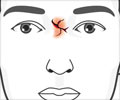Swabbing both the nose and throat in self-test kits for COVID-19 may detect SARS-CoV-2 more accurately, state researchers
- Two swabs should be used to detect SARS-CoV-2 effectively in self-antigen rapid testing kits
- Combining throat swabs with nasal swabs will increase the sensitivity and accuracy of the test
- The test detection rates are faster, higher and more specific when used together
But according to an email written by Rustem Ismagilov, Ph.D., Director of the Jacobs Institute for Molecular Engineering for Medicine, and a chemist at the California Institute of Technology, it was not effective because most people would have transmitted the disease within this period.
When the self-test antigen kits were first released in December, the test kits were designed only for nasal swabs.
At the same time, a video was posted on social media by UK Health Services. The video recommended swabbing the nose and throat together for better diagnosis of SARS-CoV-2 (1✔ ✔Trusted Source
Swab the Throat as Well as the Nose? The Debate Over the Best Way to Test for SARS-CoV-2
Go to source).
But then, scientists and other advisory boards have issued warning statements stating that there is not enough evidence to suggest the accuracy of nasal and throat swabs together. And most self-test kits were manufactured with only nasal swabs.
As the first symptom of SARS-CoV-2 is sore throat, the scientific communities have found it logical and valid to test the throat.
A series of experiments were conducted with mixed results. Some experiments proved that swabbing nose and throat instead of either nose or throat has a 4% increased accuracy rate. But the number was too small to be considered significant (4✔ ✔Trusted Source
Comparison of SARS-CoV-2 Reverse Transcriptase Polymerase Chain Reaction and BinaxNOW Rapid Antigen Tests at a Community Site During an Omicron Surge
Go to source).
Dr. Ismagilov and his team conducted two small-scale studies in December. They used PCR and the Quidel QuickVue At-Home rapid tests. They collected samples from both nasal and throat swabs separately to quantify the viral load. They found that throat swabs had higher viral loads but were still inconclusive.
So the authors decided to combine both nasal and swab tests for better detection rates instead of only nasal swabs or throat swabs (3✔ ✔Trusted Source
Extreme differences in SARS-CoV-2 viral loads among respiratory specimen types during presumed pre-infectious and infectious periods
Go to source).
After this, Nova scotia did a study to compare the results of the throat and nasal swabs, as well as both together. These were confirmed with PCR, and Binax was used as a self-test antigen kit. They have found that swabbing the throat and nose together improved the detection rates and accuracy of the test. But the studies were only at the preprint stage and were not peer-reviewed (2✔ ✔Trusted Source
Investigating the Sensitivity of Nasal or Throat Swabs: Combination of Both Swabs Increases the Sensitivity of SARS-CoV-2 Rapid Antigen Tests
Go to source).
Other studies proved that it was advantageous to use both swabs together instead. The detection rates were faster and higher when both swabs were used in combination (2✔ ✔Trusted Source
Investigating the Sensitivity of Nasal or Throat Swabs: Combination of Both Swabs Increases the Sensitivity of SARS-CoV-2 Rapid Antigen Tests
Go to source)
Read More..
Are These Self-test COVID-19 Kits Validated for Both Throat and Nasal Swabs?
Still, most self-test kits are available in the market to provide nasal swabs. These tests can only be accurate with nasal swabs. There is a drawback to using nasal swabs for the throat. It will meddle with the accuracy of the test result.Most of the manufacturers in the US are still using nasal swabs. Some countries, like Canada, and the UK have rapid antigen test kits that use throat as well as nose swabs for testing.
Will a Throat Swab Inhibit a Self-test Kit Designed for Nasal Swabs?
The answer to this is still unclear, but the salivary enzymes in the mouth may give a false negative test and affect the accuracy of the test, according to Dr. Ismagilov.Conclusion
Experts say that a nasal swab is preferred over a throat swab. But if available, nasal and throat swabs together may improve the detection rates. But throat swabbing alone is not recommended.In words of Pathologist Glenn Patriquin, MD, co-author of the Nova Scotia testing study and co-director of bacteriology at Dalhousie University’s QEII Diagnostic Microbiology Laboratory,"We always say if you’re going to swab one spot it should be the nose. We would never recommend swabbing only the throat.”
References:
- Swab the Throat as Well as the Nose? The Debate Over the Best Way to Test for SARS-CoV-2 - (https://pubmed.ncbi.nlm.nih.gov/36630109/)
- Investigating the Sensitivity of Nasal or Throat Swabs: Combination of Both Swabs Increases the Sensitivity of SARS-CoV-2 Rapid Antigen Tests - (https://journals.asm.org/doi/10.1128/spectrum.00217-22)
- Extreme differences in SARS-CoV-2 viral loads among respiratory specimen types during presumed pre-infectious and infectious periods - (https://www.medrxiv.org/content/10.1101/2022.07.13.22277113v2)
- Comparison of SARS-CoV-2 Reverse Transcriptase Polymerase Chain Reaction and BinaxNOW Rapid Antigen Tests at a Community Site During an Omicron Surge - (https://www.acpjournals.org/doi/10.7326/M22-0202)
Source-Medindia
















